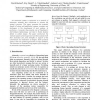Free Online Productivity Tools
i2Speak
i2Symbol
i2OCR
iTex2Img
iWeb2Print
iWeb2Shot
i2Type
iPdf2Split
iPdf2Merge
i2Bopomofo
i2Arabic
i2Style
i2Image
i2PDF
iLatex2Rtf
Sci2ools
ECBS
2005
IEEE
2005
IEEE
Towards a Systemic Approach to Autonomic Systems Engineering
An autonomic system is structured as a network of autonomic elements that collaborate to achieve the system’s purpose. This paper examines the potential benefit of using well-established systems concepts and techniques in the development of such systems. In particular, it considers the possible role of Checkland’s Soft Systems Methodology and Beer’s Viable Systems Model in system design. The paper summarizes the relevant aspects of each approach and then assesses both their individual and joint strengths in support of the construction and evaluation of designs. Some practical issues in the use of these approaches are also identified. The discussion is illustrated using aspects of the design of an autonomic operating system.
Autonomic Elements | Beer’s Viable Systems | ECBS 2005 | Hardware | Well-established Systems Concepts |
| Added | 24 Jun 2010 |
| Updated | 24 Jun 2010 |
| Type | Conference |
| Year | 2005 |
| Where | ECBS |
| Authors | David W. Bustard, Roy Sterritt, A. Taleb-Bendiab, Andrew Laws, Martin Randles, Frank Keenan |
Comments (0)

